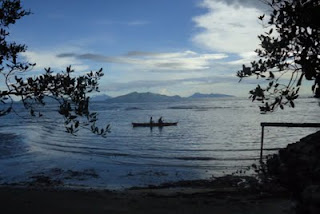
Fishermen setting out early.
Our trike driver (who, in the next few days, would give us a tour around his 'hood, pointing out his mom's house and other significant places) took us to a beach called Baot. We tried several others before coming here, but none the huts were available for rent anymore (one had animals living in it). This was about 20 to 30 minutes from the airport. It would take an hour's walk to the main road.
We had instructed him to take us to a hut. We were harboring dreams of working from a hut for a week while listening to the waves.

A swing made from driftwood.
Baot has a beautiful view of a mangrove flat. One family inhabited this shoreline, and it was a draw for very local beachgoers (this means teenagers cutting class, or people from nearby barangays renting huts to eat and drink in for the day).

Our deluxe hut.
There was an overnight hut, available for 200 pesos a night. It had a receiving room and a "master's" bedroom. Oddly, the whole floor area, save for the restroom, was covered in old carpeting. And the bedroom walls, presumably to dissuade little children from peeping into the holes that occur in natural building material, were covered by flapping curtains with poinsettia print.

To be in a room of synthetic poinsettia fabric is an experience in itself.
Now, if you are looking for basic huts along uninhabited beaches, always remember that locals have dibs on defining entertainment for that area. And that means videoke-- lots of it.





